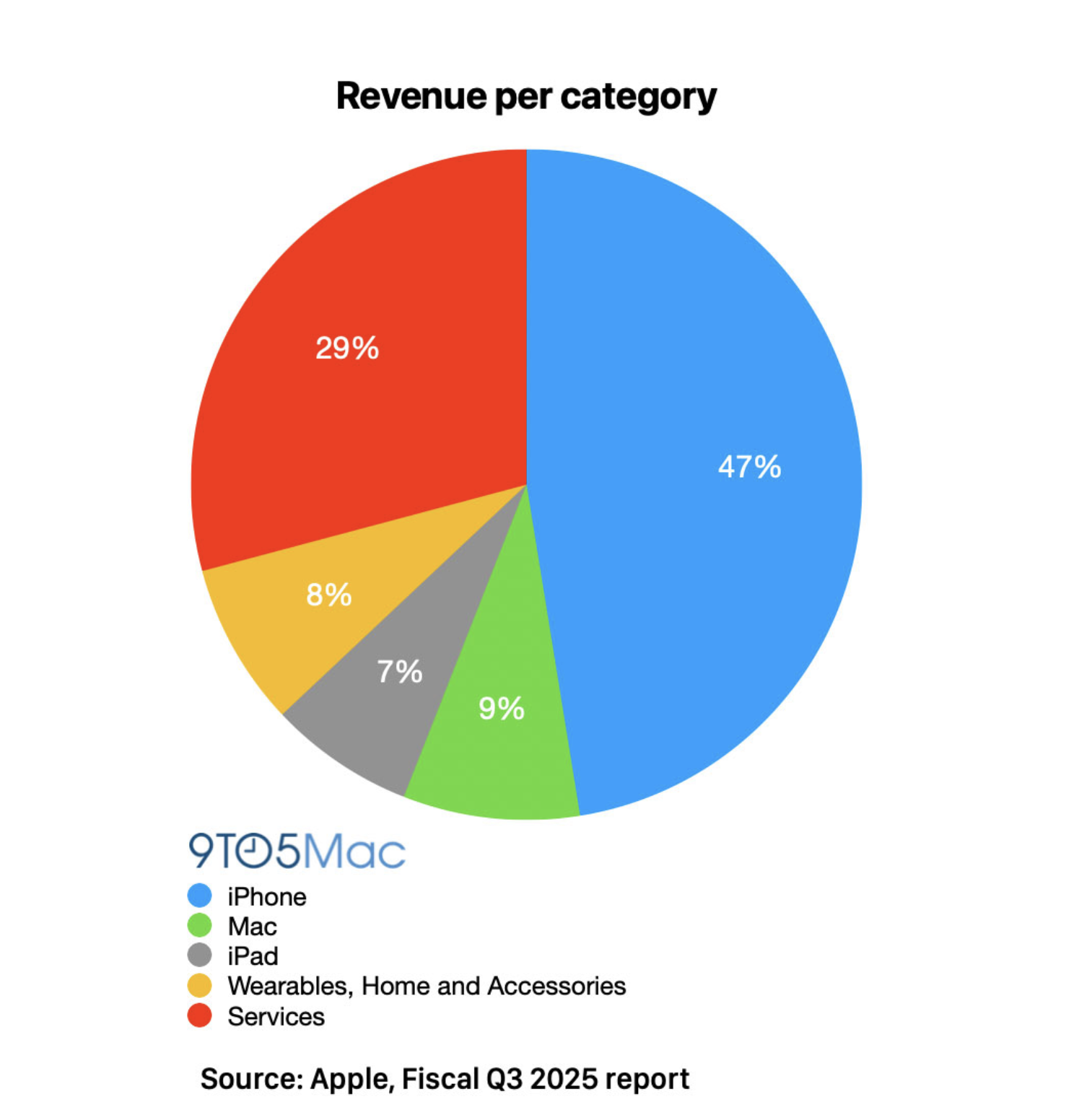Apple Finally Sets Its Sights on Maps! A Surge in iOS Ads: Is Services the New Cash Cow?
![]() 10/30 2025
10/30 2025
![]() 433
433
Bad News: More Apple Ads on the Horizon; Good News: Chinese iPhones to See Fewer.
In recent times, Apple has been weaving more commercial advertising into the fabric of the iOS system and its pre-installed apps. Now, this strategy is poised to extend to a new system-level application: Apple Maps.
Bloomberg correspondent Gurman recently divulged that Apple is on a mission to infuse more ads into iOS, with plans to roll out 'search ads' in the Maps app as early as next year.
It's been reported that the upcoming 'search ads' in Apple Maps will bear a 'striking resemblance' to the search result promotion spots already present in the App Store.
iOS developers have the option to pay for promotion, ensuring their apps are more prominently featured in the App Store. For instance, developers can opt to pay for app promotion based on user search keywords, enabling them to climb the ranks in relevant category and product search results.

(Image credit: App Store)
In a similar vein, Apple will permit a wider array of businesses, such as restaurants, to pay for promotion, ensuring their information stands out in search results within the system's Maps app.
The introduction of ads in Apple Maps has sparked comments like, 'The last ad-free map is on the verge of vanishing.'
How Many Ads Has Apple Incorporated into Its System Over the Years?
There was a time when Apple's system and pre-installed apps were devoid of commercial advertising spots for third parties.
However, following in the footsteps of Android phone manufacturers (particularly Chinese ones) that extensively explored system ad placement strategies, even Apple, with its formidable presence, has bid adieu to its 'aloof stance' and embraced a new approach of 'steady progression' to introduce more ads into iOS and its pre-installed apps.
Presently, iOS system ads are predominantly concentrated in pre-installed apps (i.e., Apple apps), including the App Store, Apple Music, Apple Wallet, Apple TV, Fitness+, Apple News, and more. To promote its own AppleCare+ service, Apple inserts a purchase link for this service in the system settings interface during the initial setup of a user's new device.
Apple's ads largely remain confined to system apps. To be fair, the placement of ad spots in the iOS system is still relatively 'restrained' and has not fully infiltrated the system interface as Android manufacturers have. Moreover, the ad placement in other Apple apps, excluding Apple News, is relatively 'tasteful' and far from the simplistic, aggressive, and attention-grabbing approach seen in Chinese Android systems.

(Image credit: Xiaomi Wallet)
Nevertheless, Apple's system apps can also disseminate the same marketing information to a vast user base through push notifications. In June of this year, the Apple Wallet app's push notification about third-party platform ticket discounts for the movie 'F1' triggered complaints from numerous users.
'Services' Emerge as Another Cash Cow for Apple
This raises a pertinent question: Why is Apple persistently pushing forward with system ad businesses that are 'destined to irk people' and negatively impact user experience and brand image?
Firstly, the system ad business has already evolved into a major revenue stream for other system manufacturers (especially Chinese Android manufacturers) and continues to expand rapidly.
Financial reports indicate that Xiaomi Group's total revenue for the first half of this year reached 227.2 billion yuan, with internet service revenue contributing 18.2 billion yuan, accounting for 8%. Advertising revenue stands as a key component of Xiaomi's internet service revenue. Benefiting from robust advertising revenue growth, Xiaomi's internet service revenue has achieved double-digit growth this year.
Secondly, under Cook's stewardship, Apple has increasingly leaned on revenue from the 'services' category, with the system ad sector still representing a blue ocean.
Apple's total revenue for the third fiscal quarter of this year stood at 94 billion USD, with service revenue reaching 27.4 billion USD, achieving double-digit growth and accounting for 29% of total revenue, 'far outpacing' all other revenue sources except the iPhone.

(Image credit: 9to5Mac)
When service revenue peaks and overall revenue growth stagnates, won't Apple's major trump card be the system ad sector, which it has been 'steadily advancing' rather than 'aggressively promoting'?
For Apple, current system ad revenue can be maintained at a relatively low contribution level, but it must continuously elevate this proportion over several years to provide a 'potential' driving force for the company's future growth.
Furthermore, with over 2.35 billion active Apple devices worldwide, the majority of which are iOS devices, 'even a sliver of the pie is worthwhile.' Leveraging such a massive number of active devices, Apple's system ad strategy can continue to progress as a 'low-priority,' 'low-perception,' and 'low-noise' initiative, as long as it does not trigger widespread doubts and opposition from users.
Finally, as the comment 'the last ad-free map is on the verge of disappearing' implies, adding more ads to system apps merely signifies that Apple is starting to 'follow the trend.'
While Apple's continuous addition of ads to system apps may not sit well with users, the vast majority are unlikely to abandon Apple devices simply due to more ads in system apps.
The core question is: If not using an iPhone, would one switch to another system's phone with 'far more' system ads? In the foreseeable future, the 'degree' of system ads on iOS devices is unlikely to match that of other system phones.
Will Chinese iPhones See an Uptick in Ads?
It's foreseeable that, not just in the Maps app, Apple will 'fully embrace ads' and 'add more ads' to iOS system apps in the future. It may even venture into bolder ad placement 'experiments' in the iOS system interface and functional interfaces.
If Apple is pursuing this strategy in the U.S. and overseas markets, what about the Chinese market?
As is well known, due to 'fierce competition' in the Chinese phone market, users of Chinese iOS devices still encounter fewer system ads compared to users of overseas versions (especially U.S. versions). Additionally, since some Apple service apps (such as Apple News, which users complain about the most for ads) have not entered the Chinese market, domestic iOS device users have fewer opportunities to stumble upon system ads compared to overseas users.
Based on these two points, it is relatively challenging for domestic users' iOS devices to witness a 'significant surge' in system app ads in the short term.
Data released mid-year reveals that among domestic mobile internet terminal brands, Huawei, Apple, and OPPO ranked in the top three with 288 million, 271 million, and 233 million active users, respectively. In the current domestic market, iOS devices not only fail to top the active user count but even face the risk of being overtaken by Huawei.
In the foreseeable future, the 'likelihood' of domestic iOS device users encountering system app ads will be the lowest among major global markets.
Moreover, even if Apple Maps introduces merchant promotion spots in search results, how many domestic users actually rely on this system app?
Apple iOS iPhone System Ads
Source: Leikeji
Note: All images in this article are sourced from the 123RF licensed image library. Source: Leikeji






